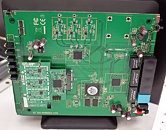- Joined
- Oct 9, 2007
- Messages
- 47,454 (7.50/day)
- Location
- Hyderabad, India
| System Name | RBMK-1000 |
|---|---|
| Processor | AMD Ryzen 7 5700G |
| Motherboard | ASUS ROG Strix B450-E Gaming |
| Cooling | DeepCool Gammax L240 V2 |
| Memory | 2x 8GB G.Skill Sniper X |
| Video Card(s) | Palit GeForce RTX 2080 SUPER GameRock |
| Storage | Western Digital Black NVMe 512GB |
| Display(s) | BenQ 1440p 60 Hz 27-inch |
| Case | Corsair Carbide 100R |
| Audio Device(s) | ASUS SupremeFX S1220A |
| Power Supply | Cooler Master MWE Gold 650W |
| Mouse | ASUS ROG Strix Impact |
| Keyboard | Gamdias Hermes E2 |
| Software | Windows 11 Pro |
Taiwan-based Edimax, which is known more for its low-cost networking hardware, took a big leap, by unveiling its first 802.11ac wireless networking hardware. These include a static router, and a USB adapter. The router uses a Broadcom-made 600 MHz Intensi-fi MIPS32 central processor. This chip has two PCI-Express interfaces, a built-in USB 2.0 host controller, and DDR2 memory controller. It has two WLAN modules, the Broadcom BCM4331 handles 802.11 b/g/n in the 2.40 GHz band, while a Broadcom BCM4360 handles 802.11ac in the 5 GHz band. This module supports network bandwidths up to 1.35 Gbps. Then you have a wired LAN interface, with one gigabit uplink port, and four gigabit downstream ports.
Moving on, Edimax showed off one of the industry's first USB 802.11ac adapters. This dongle uses Broadcom BCM43526 chip, and offers dual-band operation. In the 5 GHz band, it offers bandwidths of up to 900 Mbps, while in the 2.4 GHz band, it offers 300 Mbps. Sadly for this adapter, the USB interface is USB 2.0 HiSpeed, which poses a host bandwidth bottleneck of 480 Mbps. When you factor in things such as the various protocol overheads, the actual bandwidth yield could be much lower. Edimax is yet to name its products, so quite some development is left.



View at TechPowerUp Main Site
Moving on, Edimax showed off one of the industry's first USB 802.11ac adapters. This dongle uses Broadcom BCM43526 chip, and offers dual-band operation. In the 5 GHz band, it offers bandwidths of up to 900 Mbps, while in the 2.4 GHz band, it offers 300 Mbps. Sadly for this adapter, the USB interface is USB 2.0 HiSpeed, which poses a host bandwidth bottleneck of 480 Mbps. When you factor in things such as the various protocol overheads, the actual bandwidth yield could be much lower. Edimax is yet to name its products, so quite some development is left.



View at TechPowerUp Main Site



